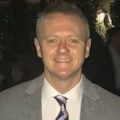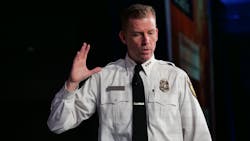FHWorld19: Camp Fire—the Fire That Changed California
The deadliest and most destructive wildfire in California's history required a massive response that involved the mobilization of various agencies, personnel, equipment and resources.
CAL FIRE Deputy Director of Communications Mike Mohler broke down the timeline of the initial response to the November 2018 Camp Fire for Firehouse World attendees during his Tuesday night session "The Camp Fire: The Fire That Changed California."
The biggest takeaway from Mohler's presentation was the fact that although the incident burned for over two weeks days until firefighters were able to contain it, most of the loss of life and property destruction happened in just the first four hours and was centered in and around the town of Paradise in Butte County.
All told, the Camp Fire burned 153,336 acres, destroyed 18,800 homes and killed 85 people.
Mohler believes that the 85 fatalities, although painfully tragic, represent a mere fraction of the potential loss of life given the circumstances, but the efforts of first responders in those first few hours saved thousands upon thousands of lives.
"When I say that this fire changed California, it really did," Mohler said, pointing out how the heartbreaking devastation has pushed lawmakers to fund robust prevention projects, and helped prompt Gov. Gavin Newsom to make a statewide emergency declaration shortly after taking office in January.
"This is a preventative emergency," Mohler said. "This is a great opportunity, and we're putting boots on the ground and implementing new projects."
When massive incidents such as the Camp Fire begin, there are difficulties in coordinating the response, so for the last few years the Governor's Office has put in place a system where the leadership of the Office of Emergency Services, CAL FIRE, the California Highway Patrol and the National Guard—"The Four Horsemen," as Mohler referred to them—come together to implement a tactical assessment and strategy.
The coordination of these four agencies offers an idea of how difficult the logistics can be in mitigating these incidents, and Mohler says it's vital for citizens to see that the leadership across their local and state emergency services are cooperating to keep them safe and save lives.
Despite the high-level coordination, the Camp Fire created problems that were entirely unique due to the low humidity and extreme wind conditions that spread the fire so quickly and made rescue efforts the primary concern as opposed to suppression in the early going.
A timeline of just the first few hours of the blaze offers a frightening glimpse of how a community and the first responders serving it can become completely overwhelmed and have to adjust established tactics on the fly.
"It was like trying to tell the military to change what they do every day when they go into battle," Mohler said. "What we're seeing now is, and what you've all probably experienced, is the first 12, 24, sometimes even the first 48 hours, we go into rescue mode. These fires are moving so quickly."
Nov. 8, 2018, 6:30 a.m.: The first reports of the Camp Fire come in after it begins near the Feather River, and firefighters have difficulty reaching the blaze because of the secluded terrain. High winds in the Jarbo Gap Canyon begin rapidly spreading the flames.
7:20 a.m.: Evacuation orders begin to be implemented for the nearby town of Pulga located to the south of the ignition area. Massive acceleration of the fire begins, with CAL FIRE estimating that the blaze was consuming hundreds of yards every second.
8:00 a.m.: The fire reaches the outskirts of Paradise, with high winds causing a firestorm of embers that jumps the fire in multiple directions, putting an untold number of homes and lives in peril. Evacuation of the entire town begins in earnest. Spot fires are reported as much as two miles ahead of the main body of fire due to the high winds.
For the next several hours, the fire chewed through the population center of the town, trapping some residents as flames surrounded them. There were only six ways out of the town, four of them impassable and eventually all six blocked by abandoned vehicles and fire. Mohler said the fact that responders got as many people out as they did can be called a minor miracle.
Dispatchers fielded over 1,700 calls for help when they normally take roughly 150 to 200 in a busy day. Some of them spoke to victims and tried to help as long as they could until the phone lines went dead, which resulted in an emotional trauma for those dispatchers that lasts to this day.
"We've gone through those calls. It's pretty intense to hear. There were several of them where they were on the phone pretty much," Mohler said, his voice catching for a moment, "until they burned up."
The fire needed only four hours to burn through about 20,000 acres, which some would call unprecedented, but Mohler says quite the opposite is true. This is now a very real precedent that California is faced with.
"I hear the term 'new normal' all the time, and this isn't new," Mohler said. "This is the normal, and we have to prepare and respond. We're not going to turn this corner in a year. We may not turn this corner in a decade."
"We took a punch in the gut with extended responses not just in 2017 but in 2018, as well. It's not first responder anymore. It's extended responder."
The fire went on to burn for 17 days until it was contained on Nov. 25, but those first few hours of rapid growth and wind-driven expansion marked a perfect storm that Mohler says he and his colleagues had talked about for nearly two decades.
They all knew that under certain conditions, if a fire were to start in that region and the winds were to align, there would be little they could do to stop it, and sadly that nightmare scenario became a reality for the people of Paradise and its surrounding communities.
"It's not all doom and gloom because we have the opportunity to make change and to look at this as fire service professionals ... Where are we going from here?" Mohler asked in closing.
"We're going to continue fighting fires. It's what we do. But we're starting to look at these communities and where they are, and how we're going to defend them, and what we can do prior to an incident and not just in response mode."
About the Author

John Kosik
John was the managing editor of Firehouse after joining the Firehouse team in April 2017 after spending most of his career in journalism writing and editing sports and music content for the Associated Press in New York City. Transitioning into coverage of the fire service industry was a move close to his heart with several friends and family members serving in the FDNY. He lives in Chicago.

